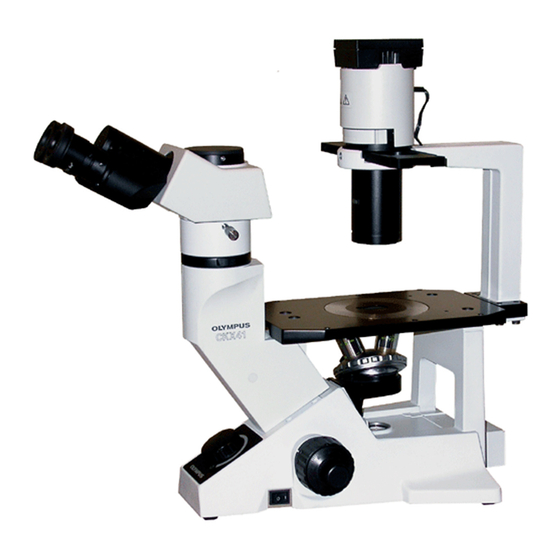Olympus CKX41 Manuel d'instructions - Page 12
Parcourez en ligne ou téléchargez le pdf Manuel d'instructions pour {nom_de_la_catégorie} Olympus CKX41. Olympus CKX41 36 pages. Reflected fluorescence system
Également pour Olympus CKX41 : Vue d'ensemble (7 pages), Brochure & Specs (4 pages), Manuel de réparation (43 pages)

- 1. Table of Contents
- 1. General Precautions for Observation
- 1. Using the Controls
- 2. Important
- 2. Applicable Fluorescence Objectives
- 3. Nomenclature
- 3. Centering the Mercury Burner
- 4. Troubleshooting Guide
- 4. Specifications
- 4. Assembly
- 4. Assembly
- 4. U-Excitation Filter Set Ckx-Nu (Optional)
- 4. Controls of each Module
- 4. Switching the Filter Slider
- 5. Proper Selection of the Power Supply Cord
- 5. Summary of Reflected Fluorescence Observation Procedure
USING THE CONTROLS
1
General Precautions for Observation
1. Confirm that the power supply unit has been set to the proper power supply voltage, power
supply frequency and burner type. Improper setting of these items may degrade burner service
life considerably.
2. Confirm that the power cord and connecting cords are connected properly.
3. When transmitted phase contrast or transmitted relief contrast observation is required, leave an open
position (BF) in the reflected fluorescent mirror slider. This position will allow the original colors to be
reproduced.
4. Stop down the field iris diaphragm until its image circumscribes the field of view. If it is decentered,
adjust centering using the Allen screwdriver. (P.16)
5. When using an LCPlanFl series objective, attach the correction cap, which compensates for the material
and thickness of the container used in observation. For the type of the correction cap to be used, refer
to the instruction manual for the CKX series culture microscopes.
6. The LUCPlanFLN20X/40X/60X, LCPlanFl40X and LUCPlanFl40X objectives with correction collar are
capable of compensating for the drop in resolution due to variance in the cover glass thickness. For
details, refer to the instruction manual for the CKX series culture microscopes.
7. When it is required to interrupt observation for a short period, use the shutter. (Repeated on-off of the
mercury burner will shorten its service life considerably.)
8. Precautions on the specimen color fading:
The system employs high-intensity excitation light to enable bright observation of dark fluorescent
specimens.
As a result, if high-power objectives are used frequently, color fading of the specimen occurs early,
degrading the view (contrast) of fluorescent images.
To delay color fading of the specimen and obtain favorable fluorescent images, it is recommended to
reduce the excitation light intensity a little.
The excitation light intensity can be reduced by using ND filters to an extent that does not hinder
observation. It is also effective to use the shutter frequently to avoid illuminating the specimen for a
longer period than required.
Color fading of the specimen can also be delayed using a commercially available color fading preventing
agent (DABCO, etc.).
The use of color fading preventing agent is recommended specially when you perform high-magnification
observation frequently.
# Note that color fading preventing agent cannot be used with certain specimens.
9
